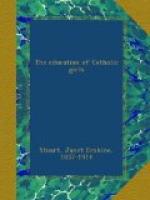3. But better than all new apparatus and books of delight is the informal study of the world around us which has grown up by the side of organized teaching of natural science. The name of “nature study” is the least attractive point about it; the reality escapes from all conventionalities of instruction, and looks and listens and learns without the rules and boundaries which belong to real lessons. Its range is not restricted within formal limits; it is neither botany, nor natural history, nor physics; neither instruction on light nor heat nor sound, but it wanders on a voyage of discovery into all these domains. And in so far as it does this, it appeals very strongly to children. Children usually delight in flowers and dislike botany, are fond of animals and rather indifferent to natural history. Life is what awakens their interest; they love the living thing as a whole and do not care much for analysis or classification; these interests grow up later.
The object of informal nature study is to put children directly in touch with the beautiful and wonderful things which are within their reach. Its lesson-book is everywhere, its time is every time, its spirit is wonder and delight. This is for the children. Those who teach it have to look beyond, and it is not so easy to teach as it is to learn. It cannot, properly speaking, be learned by teachers out of books, though books can do a great deal. But a long-used quiet habit of observation gives it life and the stored-up sweetness of years—“the old is better.” The most charming books on nature study necessarily give a second-hand tone to the teaching. But the point of it all is knowledge at first-hand; yet, for children knowledge at first-hand is so limited that some one to refer to, and some one to guide them is a necessity, some one who will say at the right moment “look” and “listen,” and who has looked and listened for years. Perhaps the requirement of knowledge at firsthand for children has sometimes been pushed a little too far, with a deadening effect, for the progress of such knowledge is very slow and laborious. How little we should know if we only admitted first-hand knowledge, but the stories of wonder from those who have seen urge us on to see for ourselves; and so we swing backwards and forwards, from the world outside to the books, to find out more, from the books to the world outside to see for ourselves. And a good teacher, who is an evergreen learner, goes backwards and forwards, too, sharing the work and heightening the delight. All the stages come in turn, over and over again, observation, experiment, inquiry from others whether orally or in books, and in this subject books abound more fascinating than fairy tales, and their latest charm is that they are laying aside the pose of a fairy tale and tell the simple truth.




